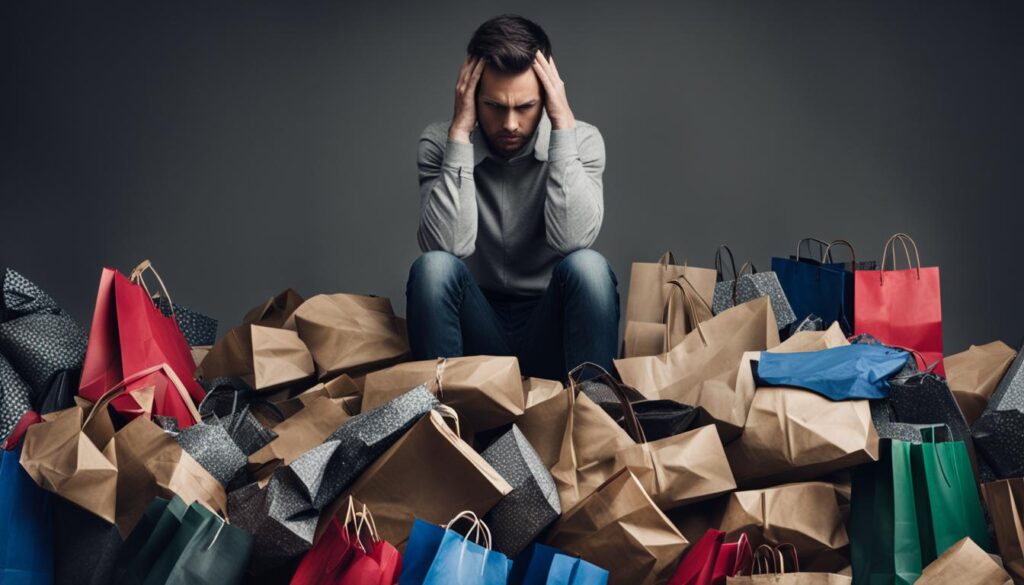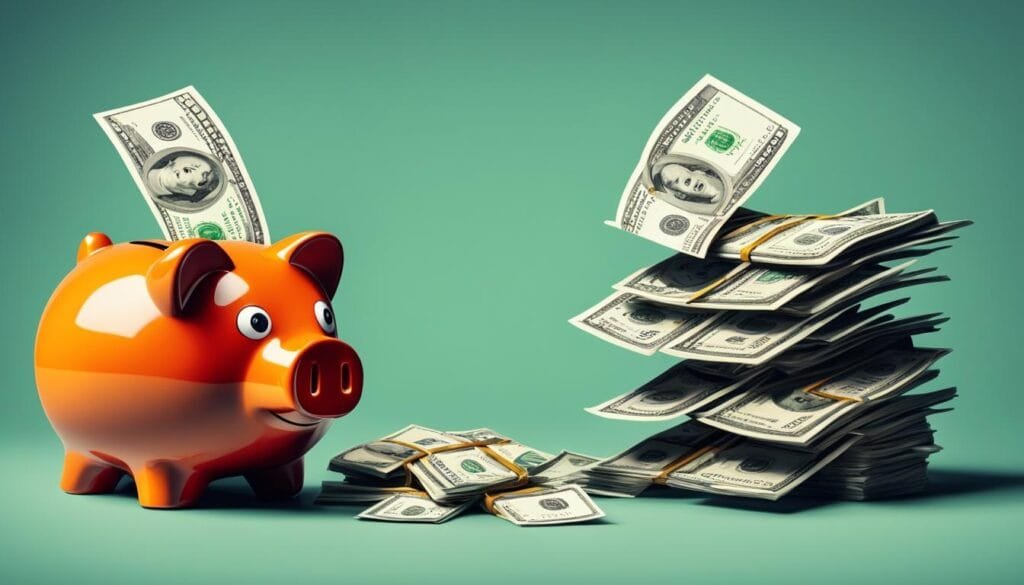Shopping addiction is a prevalent behavioral addiction that can have serious consequences. Individuals who suffer from shopping addiction experience a sense of euphoria and reward during the buying process, as it stimulates the brain’s pleasure centers.
Recognizing the signs and symptoms of shopping addiction is crucial in order to seek appropriate help and support. Common warning signs include shopping or spending money to alleviate negative emotions, obsessive thoughts about money, experiencing a rush or euphoria when making purchases, and hiding or lying about spending habits.
Key Takeaways:
- Shopping addiction can have severe consequences and should not be taken lightly.
- Common signs of shopping addiction include shopping as a coping mechanism, obsessive thoughts about money, and a rush or euphoria when spending.
- Research is ongoing to determine if shopping addiction should be recognized as a dedicated diagnosis.
- Seeking professional help and support is crucial in overcoming shopping addiction.
- Developing healthy coping mechanisms and finding alternative activities can aid in breaking the cycle of compulsive shopping.
Types of Shopping Addictions
Shopping addictions can take different forms, each with its own unique characteristics and compulsions. Understanding these types can shed light on the diverse behaviors associated with shopping addiction:
1. Compulsive Shopping
Compulsive shopping, also known as oniomania, is characterized by a consistent urge to shop and spend money, usually as a means to escape negative emotions or cope with stress. Individuals with this addiction typically experience a temporary sense of relief or pleasure when engaged in shopping activities.
2. Impulse Buying
Impulse buying refers to the act of making unplanned purchases, driven by spontaneous desires and a lack of self-control. People with this addiction often find it difficult to resist the urge to buy items, regardless of their necessity or long-term consequences.
3. Bulimic Shopping
Bulimic shopping involves a cycle of making purchases and subsequently returning them. This behavior is often fueled by feelings of guilt or regret after impulsive buying sprees, leading individuals to attempt to “purge” their excessive spending.
4. Bargain-Hunting Addiction
Bargain-hunting addicts are driven by the thrill of finding deals and discounts. They may constantly search for sales, engage in extreme couponing, or accumulate a large number of discounted items, even if they do not need them. The gratification comes from the sense of achievement associated with scoring a bargain.
5. Collectors’ Addiction
Collectors may develop an addiction that centers around buying and accumulating multiple versions of the same item. Whether it’s stamps, coins, or limited-edition items, the desire to possess and complete a collection can become all-consuming.
6. Online Shopping Addiction
Online shopping addiction has become increasingly prevalent in the digital age. The convenience, variety of options, and targeted advertisements amplify the addictive nature of online shopping. People with this addiction may spend excessive amounts of time and money browsing and purchasing items online.
It’s important to note that individuals may exhibit symptoms of more than one type of shopping addiction, as these behavioral patterns can overlap. Understanding the different forms of shopping addiction can help individuals recognize their own compulsions and seek appropriate support and treatment.
Shopping Addiction Signs and Risk Factors
Shopping addiction can have severe consequences on an individual’s life, including financial and relationship problems. It is important to recognize the warning signs of shopping addiction to prevent further harm. Here are some common shopping addiction signs:
- Excessive preoccupation with shopping: A persistent and overwhelming focus on shopping, even when not actively engaged in the activity
- Emotional attachment to the experience: Using shopping as a coping mechanism for negative emotions or stress
- Negative consequences: Experiencing financial difficulties, strained relationships, or feelings of guilt and remorse after a spending spree
In addition to these signs, there are several risk factors that can contribute to the development of shopping addiction:
- Genetics: Research suggests that certain individuals may be genetically predisposed to addictive behaviors, including shopping addiction
- Co-occurring illnesses: Mood disorders, anxiety disorders, and eating disorders often co-occur with shopping addiction, indicating a potential link between these conditions
- Societal pressures: Advertising, media, and societal expectations can exert significant influence and contribute to the development of shopping addiction
It is important to note that shopping addiction can be challenging to differentiate from everyday shopping. However, the key differences lie in the excessive preoccupation, emotional attachment, and negative consequences associated with shopping addiction.
Recognizing the signs of shopping addiction is crucial for seeking help and finding effective treatment. In the next section, we will explore the consequences of shopping addiction and how to overcome it.
Shopping Addiction Signs and Risk Factors
| Shopping Addiction Signs | Risk Factors |
|---|---|
| Excessive preoccupation with shopping | Genetics |
| Emotional attachment to the experience | Co-occurring illnesses |
| Negative consequences | Societal pressures |
Understanding the signs of shopping addiction and the underlying risk factors can help individuals identify and address their addictive behavior. By seeking professional help and implementing coping strategies, it is possible to overcome shopping addiction and regain control over one’s life.
Consequences of Shopping Addiction
Shopping addiction can have both short-term and long-term consequences. The allure of shopping and the temporary high it provides can lead individuals down a dangerous path, impacting their finances and relationships.
Short-term effects of shopping addiction often involve overspending and accumulating credit card debt. In the pursuit of the latest trends or coveted items, individuals may exceed their budgets, leading to immediate financial strain. The gratification experienced in the moment is quickly overshadowed by the looming reality of mounting bills and financial instability.
However, the consequences of shopping addiction extend far beyond the immediate financial burden. In the long term, individuals may find themselves trapped in a cycle of excessive shopping, unable to break free from the compulsive behavior. This can result in severe financial ruin, affecting one’s ability to meet basic needs and maintain a stable lifestyle.
The financial problems associated with shopping addiction can also spill over into personal relationships. Loved ones may become frustrated or feel neglected as shopping addiction consumes the individual’s time, attention, and resources. Conflicts regarding money and excessive spending can strain relationships, leading to arguments, resentment, and even the deterioration of once-solid bonds.
Moreover, the emotional toll of shopping addiction should not be underestimated. After an intense shopping spree, individuals may experience feelings of guilt, stress, and remorse. The temporary satisfaction gained from buying items quickly fades, leaving behind a sense of emptiness and dissatisfaction. This emotional rollercoaster can further disrupt mental well-being and overall happiness.
To illustrate the consequences of shopping addiction, consider the following table:
| Consequences of Shopping Addiction | Effects |
|---|---|
| Financial Problems | Spending over budget, accumulating debt, financial ruin |
| Relationship Problems | Conflicts with loved ones, strain on relationships |
| Emotional Distress | Guilt, stress, and remorse |
Recognizing the distinction between indulging in a fun shopping trip and succumbing to a shopping addiction is crucial in preventing further harm. Seeking professional help and support from therapists or support groups can provide the necessary guidance to break free from the cycle of compulsive shopping and overcome the consequences it entails.

Are there specific signs of shopping addiction that I should be aware of?
If you find yourself constantly making unnecessary purchases or experiencing financial distress due to your shopping habits, these could be shopping addiction signs revealed. Other indicators may include compulsive buying, hoarding, and obsession with sales. Seeking professional help is important if you suspect you have a shopping addiction.
Conclusion
Recognizing the signs of shopping addiction is the first crucial step towards seeking help and making positive changes. It is essential to understand that shopping addiction is a real condition that can have significant repercussions on one’s life. However, there is hope for recovery.
Seeking professional therapy can provide individuals with the necessary support and guidance to overcome their shopping addiction. A qualified therapist or counselor can help explore the underlying causes of the addiction, develop healthy coping mechanisms, and work towards breaking the cycle of compulsive shopping.
Additionally, finding alternative activities to replace shopping can be instrumental in overcoming the addiction. Engaging in hobbies, spending time with loved ones, or pursuing other interests can help fill the void that shopping once occupied. Removing temptation by avoiding triggers, such as unsubscribing from promotional emails or avoiding shopping environments, can also be beneficial in maintaining progress.
Remember, overcoming shopping addiction is a journey that requires commitment and persistence. With the right help, support, and determination, it is possible to regain control over one’s finances and well-being. Don’t hesitate to reach out for shopping addiction help and take the necessary steps towards a healthier and happier life.
FAQ
What are the signs of shopping addiction?
Signs of shopping addiction can include shopping or spending money as a result of negative emotions, obsessively thinking about money, feeling a rush or euphoria when spending, and lying or hiding spending habits.
What are the different types of shopping addictions?
Shopping addictions can manifest in various ways, including compulsive shopping as a means to escape negative emotions, impulse buying driven by spontaneous desire, bulimic shopping involving purchasing and quickly returning items, bargain-hunting addiction fueled by the thrill of finding deals, and collectors feeling compelled to buy multiple versions of the same item. Online shopping addiction can also be intensified by targeted ads and convenience.
What are the risk factors for shopping addiction?
Common risk factors for shopping addiction can include genetics, co-occurring illnesses such as mood disorders and substance use disorders, and societal pressures. People with shopping addiction often meet the criteria for mood disorders, anxiety disorders, and eating disorders.
What are the consequences of shopping addiction?
Shopping addiction can have severe consequences on an individual’s life, including financial problems and relationship issues. Short-term effects can include spending over budget and accumulating credit card debt, while long-term effects can include financial ruin and difficulty breaking the shopping cycle. Shopping addiction can strain personal relationships and lead to feelings of guilt, stress, and remorse after a spending spree.
How can shopping addiction be overcome?
Recognizing the signs of shopping addiction is the first step towards seeking help. Professional therapy can provide the necessary support and guidance to overcome this addiction. Developing healthy coping mechanisms, finding alternative activities, and removing temptation can all contribute to breaking the cycle of compulsive shopping. With the right help and support, it is possible to overcome a shopping addiction and regain control over one’s finances and well-being.

